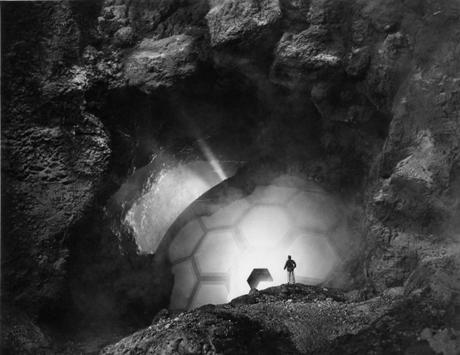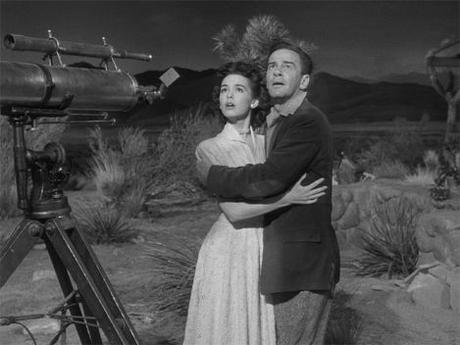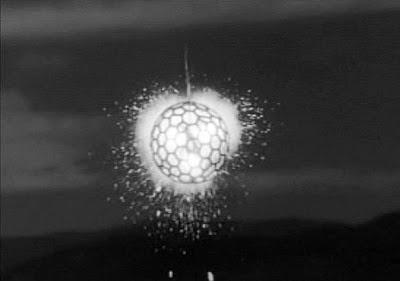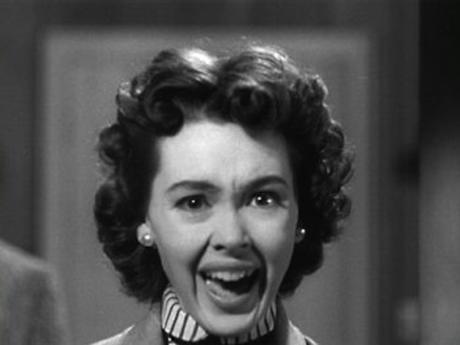 The discovery of the alien craft in It Came from Outer Space (Universal, 1953)
The discovery of the alien craft in It Came from Outer Space (Universal, 1953)An imaginary Arizona locale and desert town is the eerie setting for science-fiction author Ray Bradbury’s story of alien visitors from another world who, on their mission to a different part of the galaxy, accidentally crash land on planet Earth.
Writer and amateur astronomer John Putnam (sci-fi stalwart Richard Carlson), a recent resident of the aptly named Sand Rock, is sharing a cozy, romantic evening with local girl Ellen Fields (beautiful Barbara Rush), a grade-school teacher by profession. Suddenly, the couple witnesses a fiery meteor (or something close to it) streak across the nighttime sky.
Wasting no time, the curious pair drives out to the nearby crash site. As Putnam approaches what he believes to be a spacecraft of some kind, an unexpected landslide buries the contents within — but not before he (and the viewer, ostensibly) get a glimpse of what lies inside.
Hideous and horrible, the aliens are not your garden variety space invaders, but are instead intelligent and, it is later learned, benign beings with expansive minds and souls of their own. Unfortunately, they also have single bulbous eyes, amorphous, gelatinous bodies and the ability to assume the identity and appearance of the local populace.

Even worse, not everyone shares Putnam’s interest and curiosity about the alien visitors, especially after several of the town’s citizens mysteriously disappear and the only hardware store in sight is robbed of its electrical supplies. Hmm… what could those pesky aliens want with electrical supplies? Maybe, repair their damaged ship? Or get going with their interrupted mission?
Fear and paranoia soon grip the dusty abode, which is patrolled by chain-smoking Sheriff Matt Warren (Charles Drake). An old boyfriend of Ellen’s, Matt is overly protective of her and skeptical of Putnam’s crackpot theories about aliens. He’s not too keen on strangers either, benign or otherwise.
“Why don’t they come out into the open? Matt asks Putnam.
“Because they don’t trust us,” Putnam replies. “Because what we don’t understand we want to destroy.”
“I kill only what tries to kill me,” Matt fires back.
Putnam tries to talk some sense into the highly strung lawman. He points to an approaching arachnid.
“That spider. Why are you afraid of it? Because it has eight legs? Because its mouth moves from side to side instead of up and down? If it came at you, what would you do?”
“This,” as the sheriff crushes the spider under his boot. Point taken, point made!
Despite this seeming setback, Putnam is able to convince Matt to give him and the alien visitors more time to repair their ship. The aliens eventually release their captives and, returning to their original disgusting forms, leave the Earth in the same manner in which they approached, spewing forth a fiery trail in the sky.

A true classic of the genre, It Came from Outer Space tries to live down that egregious title and live up to its well-deserved reputation as one of the few soberly-minded and intelligently conceived sci-fi flicks of the 1950s.
Originally filmed in the 3-D process (though always shown flat in its television screenings), It Came from Outer Space was Universal-International’s first foray into the science-fiction field. In fact, the 3-D effects are rather subdued and less “in-your-face” than other examples from the period. For pure shock value, a creepy film score (credited to Irving Gertz, Henry Mancini, and Herman Stein) penetrates the soundtrack whenever the aliens are caught looming about. You may remember this theme from the old Saturday night Creature Features showcase from the 1960s and ’70s.
One of the unfortunate aspects of this and other similar releases was the studio’s bowing to Fifties convention, whereby the men are given the decisive, upright role as defenders of the realm — true movers and shakers, for good or for bad (see Howard Hawks’ The Thing from Another World).
This attitude relegated most of the women’s parts to pure window dressing or easily excitable observers. The scene in which Barbara Rush, as Ellen, answers the doorbell and screams her fool head off as she spots a boy decked out in a space invader’s outfit (with toy ray-gun in hand), is a good example of old-fashioned female hysterics.

Curiously, in another scene, the behavior of a sobbing Mrs. Frank Daylon (Virginia Mullen), the wife of one of the missing telephone linemen, contrasts sharply with that of the other missing lineman’s floozy girlfriend, Jane Dean (Kathleen Hughes). While Mrs. Daylon expresses spousal concern that Frank (Joe Sawyer) had skipped his meal and hasn’t been “himself” of late, Jane is more flippant about Frank’s partner, George (Russell Johnson):
“His landlady told me he skipped dinner. That ain’t like George, not with his appetite.” I’ll bet!
At 81 minutes, the film is compact and concise. The special effects (done via mirrors, split-screens, double exposures, swirling mists, and such) are state-of-the-art, for its time. And despite the description of the scene with Ellen, the acting is relatively low key. Subtlety and nuance, an inescapable feeling of being watched and an atmosphere of impending dread are underscored in the thoughtfully developed dialogue, courtesy of screenwriter Harry Essex. The black-and-white cinematography (by Clifford Stine) stresses the silvery noir elements. The picture was partially filmed on location in the surrounding Mojave Desert area of California, which lent a good deal of authenticity.

The movie also boosted the career of veteran documentary-maker and director Jack Arnold. Arnold went on to lend credibility to the burgeoning sci-fi arena with his subsequent outings, The Creature from the Black Lagoon (1954), with Carlson again in the lead, Revenge of the Creature and Tarantula (both from 1955 and both starring John Agar), The Incredible Shrinking Man (1957), a classic of classics, and the underrated The Space Children (1958).
In many ways, It Came from Outer Space is as rich and timely today as it ever was. Its lessons about reaching out to those in need, who may be as different from us as night is from day; to extend a helping hand and grasp the thing we’re most repelled by — by learning to overcome our basest fears and extinct for survival, while trying to understand the abnormal ways of others — continue to fascinate as well as entertain.
As the bulbous creatures fly off into the night, Putnam looks back at them in wonder and awe:
“It wasn’t the right time for us to meet,” he contemplates solemnly. “But there’ll be other nights, other stars to watch. They’ll be back.”
Indeed they will — and quite a different message from the earlier The Thing, where audiences were issued a dire warning to keep watching the skies for trouble, or the one delivered by the cultivated Klaatu in The Day the Earth Stood Still, about our bringing violence to other planets.
We need only examine another “alien invasion” feature in French-Canadian director Denis Villeneuve’s Oscar-nominated Arrival (2016), which starred Amy Adams in a glowing performance as a linguist charged with translating an indecipherable alien language that could save the world from unintended destruction.
Copyright © 2017 by Josmar F. Lopes
Advertisements
